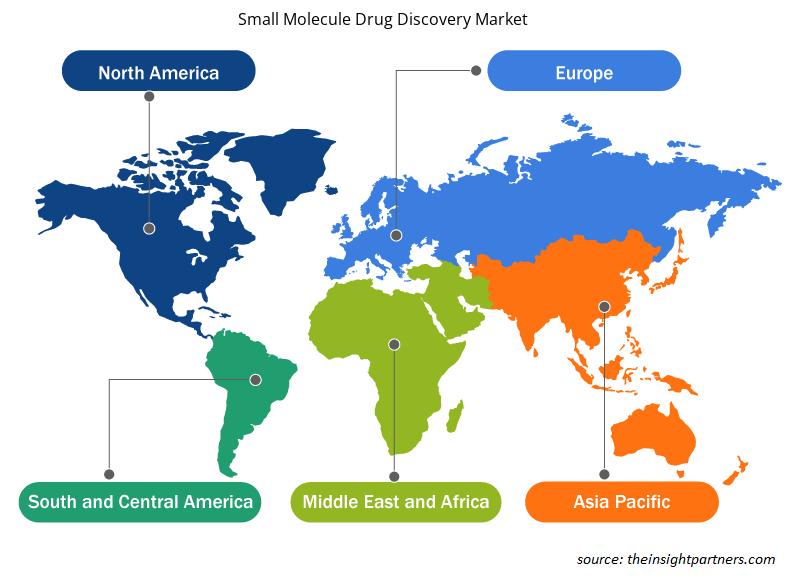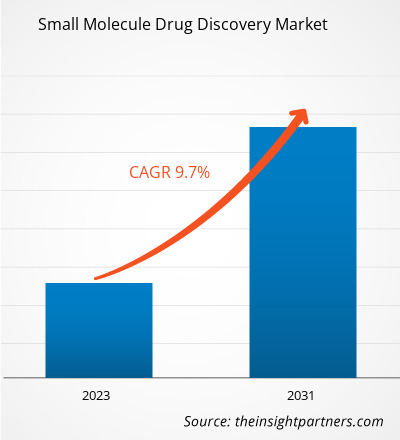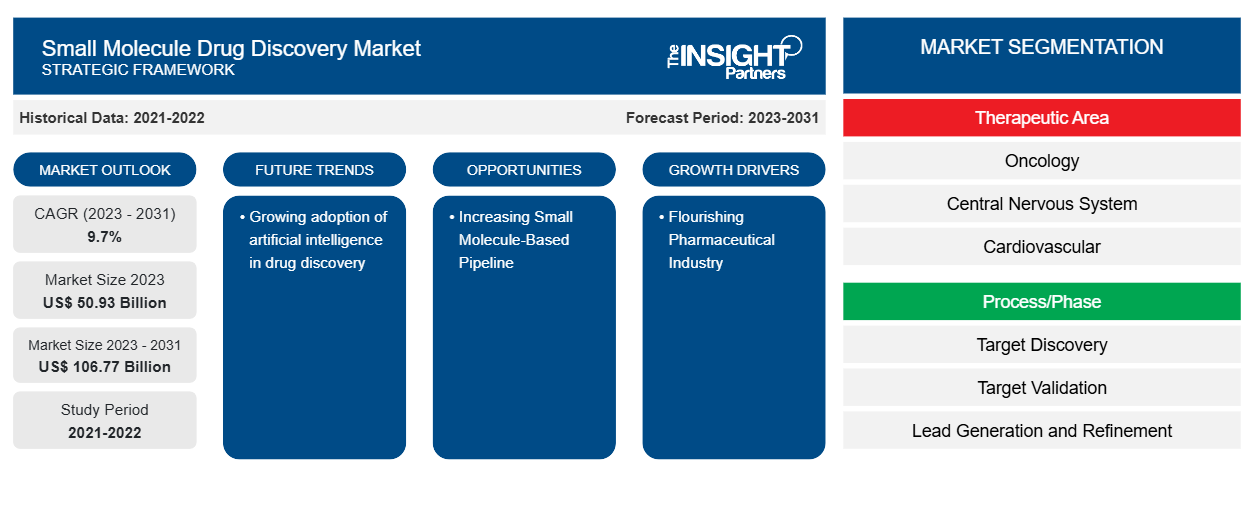Si prevede che la dimensione del mercato della scoperta di farmaci a piccole molecole raggiungerà i 106,77 miliardi di dollari entro il 2031, rispetto ai 50,93 miliardi di dollari del 2023. Si prevede che il mercato registrerà un CAGR del 9,7% nel periodo 2023-2031. È probabile che la crescente adozione dell'intelligenza artificiale nella scoperta di farmaci agisca come una tendenza futura nel mercato.
Analisi di mercato della scoperta di farmaci a piccole molecole
Il mercato della scoperta di farmaci a piccole molecole è guidato principalmente dall'aumento della R&S da parte di aziende farmaceutiche e biotecnologiche nella scoperta di nuovi farmaci, iniziative governative e prevalenza del cancro. Altri fattori che contribuiscono all'espansione del mercato includono la globalizzazione delle sperimentazioni cliniche, rapidi progressi nelle tecnologie associate e un aumento della domanda di CRO per la conduzione di sperimentazioni cliniche. Inoltre, l'aumento della pipeline basata su piccole molecole funge da opportunità per la crescita del mercato della scoperta di farmaci a piccole molecole.
Panoramica del mercato della scoperta di farmaci a piccole molecole
Si prevede che l'Asia Pacifica registrerà il CAGR più elevato durante il periodo di previsione. Un'impennata nei progressi tecnologici, un'impennata nelle collaborazioni (per lo sviluppo della ricerca genomica) tra i paesi asiatici e occidentali, una diminuzione nei prezzi del sequenziamento del DNA e una crescente prevalenza di malattie genetiche e altre malattie target stanno spingendo il mercato della scoperta di farmaci a piccole molecole dell'Asia Pacifica. Si prevede che il mercato nell'Asia Pacifica si svilupperà grazie al PIL in crescita che si traduce nella crescita dell'industria farmaceutica. Inoltre, l'aumento del reddito disponibile sta stimolando l'adozione di tecniche sanitarie avanzate . Pertanto, c'è un enorme potenziale per il mercato della scoperta di farmaci a piccole molecole grazie ai fattori sopra menzionati.
Personalizza questo report in base alle tue esigenze
Riceverai la personalizzazione gratuita di qualsiasi report, comprese parti di questo report, o analisi a livello nazionale, pacchetto dati Excel, oltre a usufruire di grandi offerte e sconti per start-up e università
-
Scopri le principali tendenze di mercato in questo rapporto.Questo campione GRATUITO includerà analisi di dati che spaziano dalle tendenze di mercato alle stime e alle previsioni.
Driver e opportunità di mercato per la scoperta di farmaci a piccole molecole
Industria farmaceutica in crescita con aumento delle attività di ricerca e sviluppo
L'industria farmaceutica è una delle industrie più intensive in R&S al mondo. Si stanno compiendo sforzi per ottenere una maggiore efficacia ed efficienza nel soddisfare le esigenze dei pazienti. Il costo dei medicinali è stato una preoccupazione primaria per le aziende farmaceutiche , poiché contano sulle loro attività di R&S per raggiungere gli obiettivi di costo previsti. Nell'ultimo decennio, il numero di nuovi farmaci a piccole molecole approvati ogni anno è aumentato drasticamente. La Food and Drug Administration (FDA) ha approvato 55 nuovi farmaci nel 2023. Le piccole molecole hanno dominato le approvazioni di nuovi farmaci nel 2023, rappresentando il 62% di tutte le nuove entità molecolari (NME) approvate. A livello globale, gli Stati Uniti sono un paese leader in termini di investimenti in R&S e il paese ha prodotto oltre il 50% delle nuove molecole del mondo nell'ultimo decennio. Un aumento delle approvazioni ha portato a crescenti investimenti da parte delle aziende per lo sviluppo di farmaci a piccole molecole a causa del loro potenziale nel trattamento di diverse gravi malattie.NME) approved. Globally, the US is a leading country in terms of R&D investments, and the country produced over 50% of the world's new molecules in the past decade. An increase in approval has led to growing investments by companies for the development of small molecule drugs due to their potential in treating several severe diseases.
Investimenti in R&S delle principali aziende farmaceutiche
Azienda |
2022 (miliardi di dollari USA) |
2023 (miliardi di dollari USA) |
|
Takeda Pharmaceutical Co Ltd Pharmaceutical Co Ltd |
4.2 |
5.08 |
|
Pfizer Inc |
11.4 |
10.6 |
|
Grifols SA SA |
427.05 |
432.71 |
Nota: per la presentazione delle valute viene preso in considerazione il tasso di conversione corrente.
Fonte: Relazioni annuali e analisi di The Insight Partners
La spesa in R&S è fondamentale negli sforzi delle aziende per scoprire, esaminare e produrre nuovi prodotti; effettuare pagamenti anticipati; migliorare i risultati esistenti; e dimostrare l'efficacia del prodotto e la conformità normativa prima del lancio. Questi investimenti variano in base alla necessità e alla domanda di scoperta di farmaci. Il costo include materiali, forniture utilizzate e stipendi dei dipendenti, insieme al costo di sviluppo del controllo di qualità. Secondo il rapporto PhRMA Member Companies 2021, le prime 15 aziende farmaceutiche più grandi per fatturato hanno investito 133 miliardi di dollari in R&S cumulativamente e circa il 44% dell'investimento totale in R&S è stato destinato alla scoperta di farmaci. Pertanto, i crescenti investimenti in R&S da parte delle aziende stanno alimentando la crescita del mercato della scoperta di farmaci a piccole molecole.
Aumento della pipeline basata su piccole molecole per offrire opportunità di crescita del mercato
L'industria farmaceutica è in continua evoluzione e c'è sempre bisogno di nuovi approcci terapeutici innovativi nel trattamento di varie indicazioni croniche. Le approvazioni di farmaci a base di piccole molecole sono aumentate negli ultimi cinque anni grazie alla loro efficacia contro un'ampia gamma di indicazioni. Le pipeline basate su farmaci candidati a base di piccole molecole stanno crescendo per un'ampia gamma di applicazioni terapeutiche, tra cui oncologia, ipertensione, diabete e disturbi infiammatori. Molte grandi e piccole aziende farmaceutiche sono impegnate nello sviluppo di diversi farmaci a base di piccole molecole.
La crescente pipeline di farmaci basati su piccole molecole per varie indicazioni sta, a sua volta, stimolando le attività di scoperta di nuovi farmaci in tutto il settore.
Nome composto |
Tipo di composto |
Nome dell'azienda |
Fase clinica |
Indicazione |
|
Codice PF-06821497 |
Piccola molecola |
Pfizer Inc. |
Phase 1 |
Cancer |
|
PF-06873600 |
Small Molecule |
Pfizer Inc. |
Phase 1 |
Breast Cancer Metastatic |
|
PF-06939999 |
Small Molecule |
Pfizer Inc. |
Phase 1 |
Solid Tumors |
|
PF-06952229 |
Small Molecule |
Pfizer Inc. |
Phase 1 |
Cancer |
|
PF-06826647 |
Small Molecule |
Pfizer Inc. |
Phase 1 |
Ulcerative Colitis |
|
PF-07038124 |
Small Molecule |
Pfizer Inc. |
Phase 1 |
Atopic Dermatitis |
|
PF-06842874 |
Small Molecule |
Pfizer Inc. |
Phase 1 |
Pulmonary Arterial Hypertension |
|
PF-06865571 |
Small Molecule |
Pfizer Inc. |
Phase 1 |
Non-alcoholic Steatohepatitis (NASH) with Liver Fibrosis |
|
PF-06882961 |
Small Molecule |
Pfizer Inc. |
Phase 1 |
Diabetes Mellitus-Type 2, Obesity |
|
PF-07081532 |
Small Molecule |
Pfizer Inc. |
Phase 1 |
Diabetes Mellitus-Type 2, Obesity |
|
R835 |
Small Molecule |
Rigel Pharmaceuticals, Inc. |
Phase 1 |
Inflammatory Disorders |
|
R552 |
Small Molecule |
Rigel Pharmaceuticals, Inc. |
Phase 1 |
Inflammatory Disorders |
|
SY-1425 |
Small Molecule |
Syros Pharmaceuticals, Inc. |
Phase 2 |
AML |
Source: Company News and The Insight Partner Analysis
Small Molecule Drug Discovery Market Report Segmentation Analysis
Key segments that contributed to the derivation of the small molecule drug discovery market analysis are therapeutic area and process/phase.
- Based on therapeutic area, the small molecule drug discovery market is segmented into oncology, central nervous system, cardiovascular, respiratory, orthopedics, immunology, rare diseases, and other therapeutic areas. The oncology segment held the largest share of the market in 2023.
- By process/phase, the market is segmented into target discovery, target validation, lead generation and refinement, and preclinical development. The lead generation and refinement segment dominated the market in 2023.
Small Molecule Drug Discovery Market Share Analysis by Geography
The geographic scope of the small molecule drug discovery market report is mainly divided into five regions: North America, Asia Pacific, Europe, South & Central America, and the Middle East & Africa. In terms of revenue, North America dominated the market in 2023. Increasing research and development by pharmaceutical and biotechnology companies in discovering novel drugs, growing investments in pharmaceuticals, and prevalence of cancer are among the factors that are projected to accelerate the growth of the North America small molecule drug discovery market. The US is the largest and fastest-growing market for small molecule drug discovery. The increasing prevalence of chronic diseases such as cardiovascular diseases and cancer primarily drives the market growth in the country. As per the American Cancer Society, in 2024, ~2 million people are projected to suffer from new cancer cases, and ~611,000 death cases are expected to be registered in the US. Owing to this scenario, the US health system witnesses massive investments in research and developments for novel drug molecules. Further, a strong drug pipeline, along with therapeutic area approvals for small molecule drugs, is expected to drive the regional market. Apart from the rising number of approved drugs, increasing awareness of advanced therapeutics is likely to be responsible for the growth of the small molecule drug discovery market during the forecast period.
Small Molecule Drug Discovery Market Regional Insights
The regional trends and factors influencing the Small Molecule Drug Discovery Market throughout the forecast period have been thoroughly explained by the analysts at Insight Partners. This section also discusses Small Molecule Drug Discovery Market segments and geography across North America, Europe, Asia Pacific, Middle East and Africa, and South and Central America.

- Get the Regional Specific Data for Small Molecule Drug Discovery Market
Small Molecule Drug Discovery Market Report Scope
| Report Attribute | Details |
|---|---|
| Market size in 2023 | US$ 50.93 Billion |
| Market Size by 2031 | US$ 106.77 Billion |
| Global CAGR (2023 - 2031) | 9.7% |
| Historical Data | 2021-2022 |
| Forecast period | 2023-2031 |
| Segments Covered |
By Therapeutic Area
|
| Regions and Countries Covered |
North America
|
| Market leaders and key company profiles |
|
Small Molecule Drug Discovery Market Players Density: Understanding Its Impact on Business Dynamics
The Small Molecule Drug Discovery Market market is growing rapidly, driven by increasing end-user demand due to factors such as evolving consumer preferences, technological advancements, and greater awareness of the product's benefits. As demand rises, businesses are expanding their offerings, innovating to meet consumer needs, and capitalizing on emerging trends, which further fuels market growth.
Market players density refers to the distribution of firms or companies operating within a particular market or industry. It indicates how many competitors (market players) are present in a given market space relative to its size or total market value.
Major Companies operating in the Small Molecule Drug Discovery Market are:
- Bristol-Myers Squibb Co
- Merck KGaA
- GSK Plc
- Boehringer Ingelheim International GmbH
- Thermo Fisher Scientific Inc
- ICON Plc
Disclaimer: The companies listed above are not ranked in any particular order.

- Get the Small Molecule Drug Discovery Market top key players overview
Small Molecule Drug Discovery Market News and Recent Developments
The small molecule drug discovery market is evaluated by gathering qualitative and quantitative data post primary and secondary research, which includes important corporate publications, association data, and databases. A few of the developments in the market are listed below:
- Oncodesign Services (ODS) ha acquisito ZoBio, un CRO olandese esperto nella scoperta di farmaci a piccole molecole basata sulla biofisica. Questa acquisizione consente a ODS di rafforzare ed estendere la propria competenza e capacità nel campo della scoperta di farmaci a piccole molecole a un'offerta completamente integrata per supportare i programmi innovativi dei propri clienti dalla convalida del target alla selezione dei candidati. (Fonte: Oncodesign Services, sito Web aziendale, gennaio 2024)
- Merck ha avviato nuove collaborazioni strategiche per la scoperta di farmaci volte a sfruttare le potenti capacità di progettazione e scoperta basate sull'intelligenza artificiale (IA), promuovendo ulteriormente gli sforzi di ricerca dell'azienda. Si prevede che la partnership tra BenevolentAI (Londra, Regno Unito) ed Exscientia (Oxford, Regno Unito) genererà diversi nuovi candidati farmaci per lo sviluppo clinico con potenziale first-in-class e best-in-class in aree terapeutiche chiave di oncologia, neurologia e immunologia. (Fonte: Merck, sito Web aziendale, settembre 2023)
Copertura e risultati del rapporto di mercato sulla scoperta di farmaci a piccole molecole
Il rapporto "Small Molecule Drug Discovery Market Size and Forecast (2021–2031)" fornisce un'analisi dettagliata del mercato che copre le seguenti aree:
- Dimensioni e previsioni del mercato della scoperta di farmaci a piccole molecole a livello globale, regionale e nazionale per tutti i segmenti di mercato chiave coperti dall'ambito
- Tendenze del mercato della scoperta di farmaci a piccole molecole, nonché dinamiche di mercato quali fattori trainanti, limitazioni e opportunità chiave
- Analisi PEST e SWOT dettagliate
- Analisi di mercato sulla scoperta di farmaci a piccole molecole che copre le principali tendenze di mercato, il quadro globale e regionale, i principali attori, le normative e i recenti sviluppi del mercato
- Analisi del panorama industriale e della concorrenza che copre la concentrazione del mercato, l'analisi della mappa di calore, i principali attori e gli sviluppi recenti per il mercato della scoperta di farmaci a piccole molecole
- Profili aziendali dettagliati
- Analisi storica (2 anni), anno base, previsione (7 anni) con CAGR
- Analisi PEST e SWOT
- Valore/volume delle dimensioni del mercato - Globale, Regionale, Nazionale
- Industria e panorama competitivo
- Set di dati Excel
Report recenti
Rapporti correlati
Testimonianze
Motivo dell'acquisto
- Processo decisionale informato
- Comprensione delle dinamiche di mercato
- Analisi competitiva
- Analisi dei clienti
- Previsioni di mercato
- Mitigazione del rischio
- Pianificazione strategica
- Giustificazione degli investimenti
- Identificazione dei mercati emergenti
- Miglioramento delle strategie di marketing
- Aumento dell'efficienza operativa
- Allineamento alle tendenze normative























 Ottieni un campione gratuito per - Mercato della scoperta di farmaci a piccole molecole
Ottieni un campione gratuito per - Mercato della scoperta di farmaci a piccole molecole